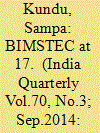| Srl | Item |
| 1 |
ID:
132906


|
|
|
|
|
| Publication |
2014.
|
| Summary/Abstract |
Bay of Bengal Initiative for Multi-sectoral Technical and Economic Cooperation, the inter-regional mechanism which was initiated primarily as a combination of India's Look East Policy and Thailand's Look West Policy, need to be reviewed in terms of achievements and difficulties faced so far as it has already completed first 16 years of existence. This article aims to identify its shortfalls and positive aspects in order to understand its potential, if there are any.
|
|
|
|
|
|
|
|
|
|
|
|
|
|
|
|
| 2 |
ID:
157731


|
|
|
|
|
| Summary/Abstract |
The regionalisation of the world economy is one of the most important developments in global governance in the past two decades. This process has seen ‘inter-regional’ economic agreements emerge between two or more regional groupings. Drawing mainly on the European Union’s external relations, observers accordingly point to the growing importance of regional actors, explaining their agency (or ‘actorness’) with regional attributes such as (supranational) institutional design, size, and member state cohesion. This article challenges this dominant explanation of regional agency. It argues that regional actors are socially, politically, and historically ‘embedded’. Agency reflects the contingency of regional integration processes, the motivations that underpin those processes, and the specific relationships between regions and third parties. This approach explains an important case of inter-regionalism from the Asia-Pacific: CER-ASEAN relations. Since the early 1990s, Australia and New Zealand have used their ‘Closer Economic Relations’ trade agreement for relations with the Association of Southeast Asian Nations. This reflects the ambitions of Australasian officials to shape processes of Asian-Pacific regionalism, and the interests of ASEAN officials in consolidating their own process of transnational market-making. Here, regional agency owed to a transforming world economy and the reconceptualisation of regions within new networks of trade governance.
|
|
|
|
|
|
|
|
|
|
|
|
|
|
|
|
| 3 |
ID:
163371


|
|
|
|
|
| Summary/Abstract |
Rising powers are evolving centres for varieties of conflict as well as development. With a focus on the complexities of the Horn of Africa, we juxtapose Jan Nederveen Pieterse1 on what is rising – States? Inter-regionalisms? Diasporas? Economies? Companies? New technologies? – with the late Jim Hentz2 on non-traditional security (NTS) challenges on the continent. NTS factors include fragile states/ungoverned spaces, migrations and viruses, which continue to undermine contemporary state and governance structures inside and around Africa. In turn, NTS challenges demand alternative and creative ways to address them. We show how the Horn of Africa illustrates all these and other emergent factors in differing proportions over time, including the diversity of diasporas, both intra- and extra-regional. Further, we argue that rising powers internal and regional transnational tensions could impact human security for the foreseeable future. Thus, affecting the prospects for meeting Sustainable Development Goals (SDGs) in the Global South.
|
|
|
|
|
|
|
|
|
|
|
|
|
|
|
|